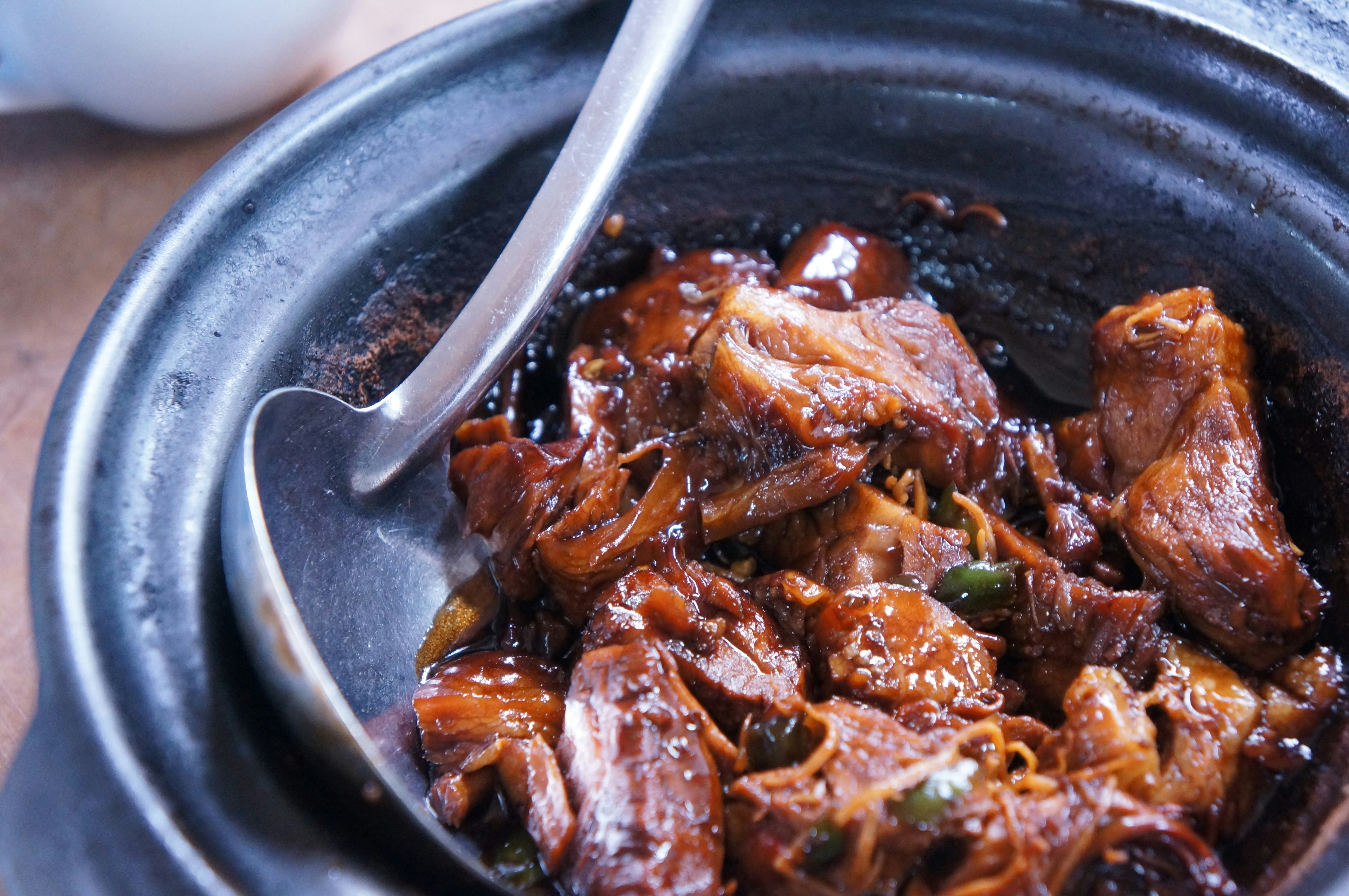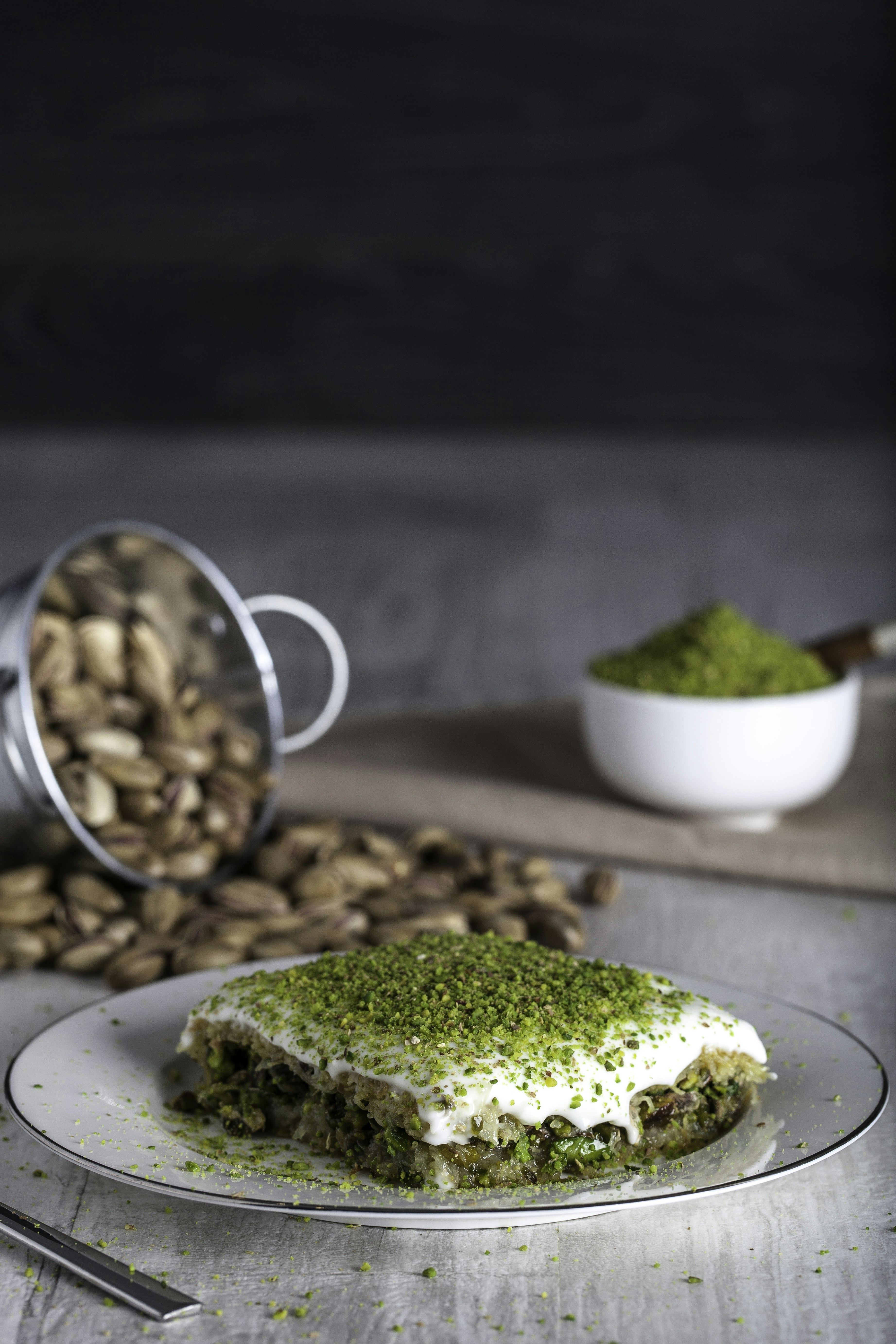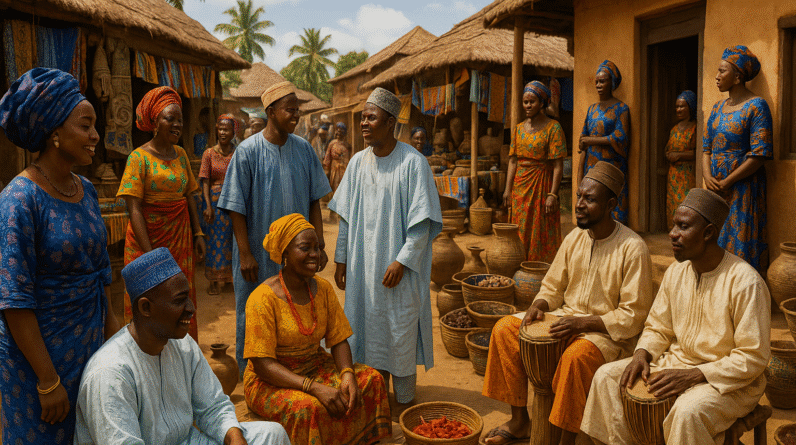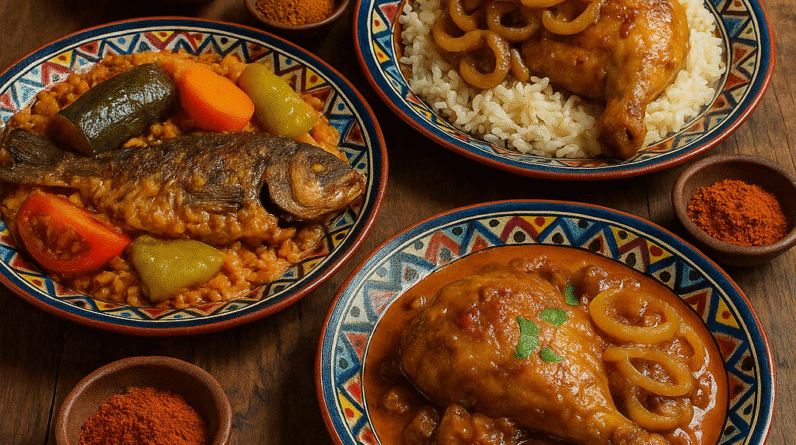
Exploring the Cuisine of Senegal
Exploring the Cuisine of Senegal. Have you ever thought about trying Senegalese cuisine? Whether you are a food enthusiast looking to try new flavors or planning a trip to Senegal and want to know more about what to expect, this article will guide you through the rich culinary landscape of this West African country.
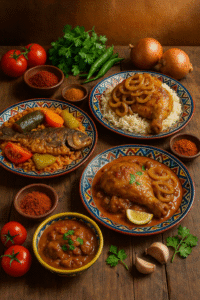
Introduction to Senegalese Cuisine
Senegalese cuisine is a fusion of flavors influenced by various cultures, including French, Portuguese, and Lebanese. From flavorful stews to spicy grilled meats, the food in Senegal offers a unique and delicious dining experience that you won’t soon forget.
What Makes Senegalese Cuisine Unique
Senegalese cuisine is characterized by the use of fresh ingredients such as fish, poultry, vegetables, and rice. The combination of flavors and spices creates a complex and rich taste that is both satisfying and memorable. One of the most popular dishes in Senegal is Thieboudienne, a rice and fish dish cooked with vegetables and spices.
Key Ingredients Used in Senegalese Cuisine
Understanding the key ingredients used in Senegalese cuisine will help you appreciate the flavors and textures of the dishes you try.
Fish
As a country with a coastline along the Atlantic Ocean, it’s no surprise that fish is a staple in Senegalese cuisine. Freshly caught fish, such as tilapia, mackerel, and grouper, are often grilled or fried and served with spicy sauces or rice. Fish is also a key ingredient in dishes like Thieboudienne, Senegal’s national dish.
Rice
Rice is a common staple in Senegalese cuisine and is often served alongside meat, fish, or vegetables. It is used in dishes like Thieboudienne, where it is cooked with fish, tomatoes, and various vegetables to create a flavorful and filling meal.
Vegetables
Senegal is known for its flavorful and colorful vegetable dishes. Vegetables such as eggplant, okra, and cassava are commonly used in stews and sauces to add texture and nutrition to the meal. Peppers and onions are also popular ingredients used to add depth and spice to Senegalese dishes.
Spices
Spices play a crucial role in Senegalese cuisine, adding depth and complexity to the dishes. Common spices used in Senegalese cooking include cayenne pepper, garlic, ginger, and thyme. These spices are used in marinades, sauces, and stews to enhance the flavors of the meat, fish, and vegetables.
Popular Senegalese Dishes to Try
When exploring Senegalese cuisine, there are several dishes that you must try to get a true taste of the country’s culinary traditions.
Thieboudienne, often referred to as the national dish of Senegal, is a flavorful and aromatic rice and fish dish cooked with vegetables and spices. The fish is typically stuffed with a tangy herb mixture before being cooked with rice, tomatoes, and other vegetables. Thieboudienne is a must-try dish for anyone visiting Senegal.
Yassa Poulet
Yassa Poulet is a popular Senegalese chicken dish that is marinated in a tangy marinade made with onions, lemons, and mustard before being grilled or fried. The chicken is then served with rice, vegetables, and sometimes a side of plantains or couscous. Yassa Poulet is a delicious and satisfying meal that showcases the bold flavors of Senegalese cuisine.
Mafe
Mafe is a hearty peanut and tomato stew that is commonly made with beef, chicken, or fish. The dish is made by simmering meat in a rich tomato and peanut sauce until tender and flavorful. Mafe is often served with rice or couscous and is a comfort food staple in Senegalese households.
Eating Etiquette and Customs in Senegal
In Senegal, eating is a social activity that is often shared with friends and family. Understanding the eating etiquette and customs in Senegal will help you navigate dining experiences with ease and respect for local traditions.
Sharing Food
In Senegalese culture, it is common for meals to be shared with others, whether it’s eating from a communal dish or passing food around the table. Sharing food is a way to foster community and connection, so be prepared to participate in this social dining practice when in Senegal.
Eating with Hands
In Senegalese culture, eating with your hands is a common practice, especially when eating dishes like Thieboudienne and Yassa Poulet. Using your hands to eat is seen as a way to connect with your food and fully savor the flavors of the meal. If you are unsure how to eat with your hands, don’t be afraid to ask for guidance from your hosts or observe others at the table.
Greetings Before and After Meals
Before and after a meal in Senegal, it is customary to greet your fellow diners with a welcoming phrase such as “Bon appétit” or “Jerejef” (thank you). This gesture shows respect and appreciation for the food and the company you are sharing the meal with. Make sure to acknowledge your hosts and express gratitude for their hospitality.
This image is property of images.unsplash.com.
Street Food Culture in Senegal
Senegal is known for its vibrant street food culture, with bustling markets and food stalls offering a variety of savory and sweet treats. Exploring the street food scene in Senegal is a great way to experience the local flavors and interact with the community.
Popular Street Food in Senegal
Some of the most popular street foods in Senegal include:
- Pain Senegalais: A baguette-style bread that is crispy on the outside and soft on the inside, often served with butter or cheese.
- Dibi: Grilled meat skewers that are seasoned with spices and served with onions and mustard sauce.
- Beignets: Deep-fried doughnuts that are coated in sugar and often filled with jam or chocolate.
- Kossam: A sweet and refreshing drink made from hibiscus flowers, sugar, and water.
Etiquette When Eating Street Food
When enjoying street food in Senegal, it is essential to observe proper etiquette to ensure a positive and respectful experience. Here are a few tips to keep in mind:
- Ask Questions: Don’t be afraid to ask vendors about the ingredients and preparation methods of the food they are serving.
- Use Hand Sanitizer: To maintain hygiene, it is a good idea to use hand sanitizer before and after eating street food.
- Dispose of Trash Properly: Be mindful of where you dispose of your trash and try to leave the area as clean as you found it.
Traditional Drinks in Senegal
In addition to delicious cuisine, Senegal also offers a variety of traditional drinks that are refreshing and unique to the region. Exploring Senegalese beverages will give you a glimpse into the country’s rich drinking culture.
Bissap
Bissap is a popular drink in Senegal made from hibiscus flowers, water, and sugar. The drink has a vibrant red color and a sweet-tart flavor that is both refreshing and hydrating. Bissap is often served cold over ice and is a favorite beverage during hot summer days.
Ginger Juice
Ginger juice is a spicy and invigorating drink made from fresh ginger, sugar, and water. The drink is known for its warming properties and is often consumed to soothe digestion or alleviate cold symptoms. Ginger juice is a versatile drink that can be enjoyed hot or cold, depending on your preference.
Bouye
Bouye is a creamy and sweet drink made from baobab fruit pulp, milk, and sugar. The drink has a thick texture and a rich flavor that is reminiscent of vanilla and caramel. Bouye is a popular beverage in Senegal and is often served at special occasions or as a dessert drink.
Culinary Tours and Cooking Classes in Senegal
If you are eager to learn more about Senegalese cuisine and immerse yourself in the culinary traditions of the country, consider joining a culinary tour or taking a cooking class in Senegal. These experiences will give you the opportunity to learn from local chefs, explore bustling markets, and discover new flavors and techniques.
Culinary tours in Senegal offer a guided journey through the vibrant food scene of the country, with opportunities to taste a variety of dishes, meet local chefs, and learn about the cultural significance of Senegalese cuisine. Whether you are a food enthusiast or a novice cook, a culinary tour in Senegal is a fantastic way to deepen your appreciation for the local food culture.
Cooking Classes
Cooking classes in Senegal provide a hands-on experience where you can learn how to prepare traditional dishes from scratch. Under the guidance of a skilled chef, you will explore the flavors and techniques of Senegalese cooking, from selecting fresh ingredients to mastering the art of seasoning and spicing. Cooking classes are a fun and interactive way to gain insight into the culinary traditions of Senegal.
Frequently Asked Questions (FAQs) about the cuisine of Senegal, with detailed answers:
1. What is the national dish of Senegal?
Thieboudienne (also spelled ceebu jën or benachin) is Senegal’s flagship dish — fish cooked with broken rice, tomato sauce, and mixed vegetables in a single pot. It’s even recognized by UNESCO as an intangible cultural heritage (en.wikipedia.org).
2. What are the other staple dishes?
- Yassa: Marinated chicken (or fish/lamb) with onions, lemon, and mustard, served over rice (thewanderingafro.com).
- Mafé: A hearty stew of meat (mostly beef, lamb, or chicken) in a creamy peanut-tomato sauce, typically served with rice (togetherwomenrise.org).
- Caldou (or kaldou): A lighter fish-and-vegetable broth simmered with onions, tomatoes, and citrus, served with rice (discover-senegal.com).
- Domoda: A French-influenced tomato‑thickened sauce made with meat or fish, served over rice (en.wikipedia.org).
- Dibi: Fire-grilled lamb or beef seasoned and served with onions, mustard, bread, and sometimes plantains or fries (thewanderingafro.com).
3. What snacks and street‑food items are popular?
- Accara (akaras): Black-eyed-pea fritters served with spicy ketchup-like sauce (sosu kaani) (saveur.com).
- Pastels: Fried fish- or veggie-filled pastries soaked in spicy tomato sauce (discover-senegal.com).
- Fataya: Meat- or fish-filled deep-fried turnovers (thewanderingafro.com).
- Street‑food evolution: In Dakar, street stalls feature a fusion of local and regional influences—from Vietnamese-inspired nems to meat skewers by West African migrants (travelsenegal.wordpress.com).
4. What are common staples and ingredients?
Rice is the central carbohydrate, often paired with millet (thiéré) or fonio in some regions (en.wikipedia.org). Fish is a major protein source, thanks to Senegal’s Atlantic coastline (kitchenconnection.org). Peanuts underpin many dishes—used as oil, roasts, or in sauces—rooted in Senegal’s colonial peanut economy (epicurious.com).
5. How is food typically eaten in Senegal?
Meals are often communal, with diners sharing from a large central bowl using spoons or hands (after washing) (togetherwomenrise.org). Elders or hosts may serve meat or fish to guests, and finishing off with tea is a common practice (reddit.com).
6. What beverages and desserts are typical?
- Bissap: A tart-sweet hibiscus drink often served cold (thewanderingafro.com).
- Attaya: Traditional Senegalese tea enjoyed socially.
- Thiakry: A sweet millet-and-yogurt dessert, also a street snack (whats4eats.com, lemonde.fr).
- Desserts blend French flair with local ingredients—coconut rice puddings (sombi), fruit salads, and freshly baked sweets often conclude meals (saveur.com).
7. How does culture influence cuisine?
Senegalese cuisine is an intricate blend of local Wolof traditions, Islamic dietary customs (e.g., minimal pork), French colonial influence, and regional migrations (Malian, Nigerian, Lebanese, Vietnamese) (en.wikipedia.org).
8. What should visitors know about dining etiquette?
- Wash hands before eating & share plates communally (reddit.com).
- Eat within your immediate space; central items are communal.
- Declining offered food politely is accepted, but taking at least a taste is respectful.
- Meals often finish with tea, marking hospitality.
✅ Summary
Senegalese cuisine is celebrated for its rich, communal dishes rooted in rice and seafood or meat, vibrant sauces like mafé and yassa, and confectionery and drinks reflecting local and French heritage. Shared tables and tea ceremonies embody Senegal’s spirit of teranga (warm hospitality).
Let me know if you’d like recipes, restaurant recommendations, or deeper dives into specific dishes!
By exploring the cuisine of Senegal, you are not only indulging in delicious flavors but also immersing yourself in the rich culture and traditions of this West African country. From vibrant street food to decadent dishes, Senegalese cuisine offers a culinary adventure that will delight your taste buds and leave you craving more. So, are you ready to embark on a gastronomic journey to Senegal?


